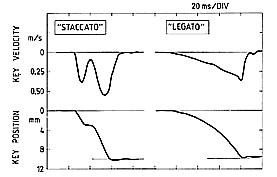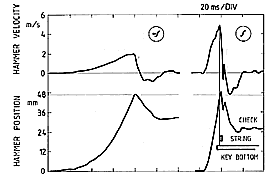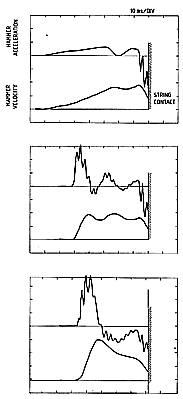
The motions of the key and the hammer
[<- Previous]
[Contents of this lecture]
[Next ->]
Leaving the timing aspect of the processes in the action, we now turn to the actual motions of the key and hammer. These motions were measured by means of an inexpensive optical system, developed with an ordinary reflex camera as a central part. A position sensitive photodetector which replaced the film in the camera registered the positions of small light sources on the key and hammer.
Key motion
The motion of the key turned out to be very different for different types of touch. In a touch with the finger striking the key from some distance above ("staccato"), the key normally made a temporary "stop" during its descent (see Fig. 9, left). This is seen as a plateau in the key position curve at about a third of the key travel, and more clearly in the key velocity curve which oscillates up-and-down due to the temporary retardation. This strange motion of the key was found to be connected with a resonance in the hammer. The reason is that during a "staccato-touch" a strong, initial impulse is delivered to the base of the hammer shank via the jack and roller. This impulse sets the hammer in vibration, the relatively heavy hammer head oscillating up-and-down on the flexible hammer shank. The bending motion of the hammer shank is partly transferred back via the action to key, where it can be measured and probably also perceived by the pianist as some kind of "response" from the instrument.
In a touch with the finger initially resting on the key ("legato"), the motion always followed a smooth path. A typical example is shown in Fig. 9 (right).
The key velocities are generally rather low. At mezzo forte (cf. Fig. 9), the maximum velocities are approximately 0.3 - 0.5 m/s. Even in forte the peak velocity does seldom exceed 1 m/s (about 4 km/h).
 Fig. 9. Influence of different types of touch on the key motion (mezzo forte, C4). The two cases represent a staccato-touch with the finger starting its motion from some distance above the key (left), and a legato-touch with the finger initially resting on the key (right).
Fig. 9. Influence of different types of touch on the key motion (mezzo forte, C4). The two cases represent a staccato-touch with the finger starting its motion from some distance above the key (left), and a legato-touch with the finger initially resting on the key (right).
Hammer motion
The hammer must travel a distance which is approximately five times longer than the travel of the key in essentially the same time. Consequently, the hammer velocities are about five times higher than the key velocities. Two typical examples are given in Fig. 10 which shows a mezzo forte and forte touch, respectively. In the forte example, the maximum hammer velocity is about 5 m/s (18 km/h), not very far from the highest velocity observed during the experiments. Observe the short moment of hammer-string contact indicated in the figure, and also that the hammer is checked at a lower level in forte because of the higher return velocity when rebounding from the string.
 Fig. 10. Typical registrations of hammer position and velocity at mezzo forte and forte (C4). The horizontal line indicates the level of the string. Note the short moment of hammer-string contact and the differences in check level.
Fig. 10. Typical registrations of hammer position and velocity at mezzo forte and forte (C4). The horizontal line indicates the level of the string. Note the short moment of hammer-string contact and the differences in check level.
Depending on the touch, the motion of the hammer can be quite different, even when the dynamic level is kept constant. The examples in Fig. 11 show the hammer velocity and acceleration for three different types of touch as measured at the hammer head. Indeed, the motion of the hammer before string contact is different in the three examples, despite the fact that the final velocities were approximately the same. At the moment it may suffice to note that the hammer motion seems to involve two components of oscillation, which are excited differently depending on the touch. One is a slow "backwash" motion at about 50 Hz and the other is a "ripple" type motion at about 400 Hz. While the slow motion is more prominent in the gentle types of touch, the "ripple" motion seems to be a characteristic of the vigorous, impulse-like types of touch.
 Fig. 11. Influence of different types of touch on the hammer motion (acceleration and velocity) mezzo forte, B3. The pianist described the types as: "middle finger only" (top), "heavy arm with relaxed finger" (middle), "heavy arm with strained finger" (bottom).
Fig. 11. Influence of different types of touch on the hammer motion (acceleration and velocity) mezzo forte, B3. The pianist described the types as: "middle finger only" (top), "heavy arm with relaxed finger" (middle), "heavy arm with strained finger" (bottom).
The perceptual differences between these notes were only rated informally. The pianist described the differences in tone character as large, but the experimenters on the other hand, had the impression that the differences were rather subtle. A formal evaluation would need a reliable listening test according to one of the recognized (and elaborate) methods prescribed by music psychologists, including a close control of the dynamic level.
[<- Previous]
[Top]
[Contents of this lecture]
[Next ->]
This lecture is one of Five lectures on the
Acoustics of the piano
© 1990 Royal Swedish Academy of Music
 Fig. 9. Influence of different types of touch on the key motion (mezzo forte, C4). The two cases represent a staccato-touch with the finger starting its motion from some distance above the key (left), and a legato-touch with the finger initially resting on the key (right).
Fig. 9. Influence of different types of touch on the key motion (mezzo forte, C4). The two cases represent a staccato-touch with the finger starting its motion from some distance above the key (left), and a legato-touch with the finger initially resting on the key (right).

 Fig. 10. Typical registrations of hammer position and velocity at mezzo forte and forte (C4). The horizontal line indicates the level of the string. Note the short moment of hammer-string contact and the differences in check level.
Fig. 10. Typical registrations of hammer position and velocity at mezzo forte and forte (C4). The horizontal line indicates the level of the string. Note the short moment of hammer-string contact and the differences in check level.
 Fig. 11. Influence of different types of touch on the hammer motion (acceleration and velocity) mezzo forte, B3. The pianist described the types as: "middle finger only" (top), "heavy arm with relaxed finger" (middle), "heavy arm with strained finger" (bottom).
Fig. 11. Influence of different types of touch on the hammer motion (acceleration and velocity) mezzo forte, B3. The pianist described the types as: "middle finger only" (top), "heavy arm with relaxed finger" (middle), "heavy arm with strained finger" (bottom).